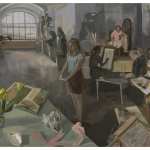I wrote about this visit with Sarah Morris so long ago, I’d forgotten all about it, but it’s finally in print at the Brown Alumni Magazine. Morris’s best-known paintings and films are preoccupied with cities and the social impact of urbanization, so it seems apt that her studio, on the fifteenth floor of a high-security building, has a spectacular view of the Manhattan skyline. There, she and her assistants juggle multiple large-scale projects destined for cities around the globe. On her slate this spring were solo exhibitions in Seoul and Biot, France; and public art projects in Germany, Norway, and New York City. Here’s an excerpt from the article.
“Morris’s workspace looks more like an office than an artist’s studio. In the front room, two big iMacs face each other on white desks stacked with reference books. The walls are lined with digital proofs and metal shelves full of books, many of which are about Morris’s own work. At Brown University, Morris concentrated in political science and literature and society, and as she talks it becomes clear that studying political philosophy and aesthetics has shaped her art. For her, the history of a color and the particular references it evokes are just as important as its visual qualities. Tellingly, she says her favorite course was one that modern culture and media professor Neil Lazarus taught on “commodity aesthetics,” which explored the political content inherent in aesthetic choices.
“After graduation, Morris moved to New York, where she entered the Whitney Independent Study Program…. By the mid-1990s, Morris was beginning to make the abstract geometric paintings and films for which she is best known. Her early paintings were cropped views of modern skyscrapers, as seen from street level. Politically, they seemed to question the urban experience, the illusion of corporate transparency, and the individual’s relationship to corporate globalism. On an aesthetic level, they challenged the line between abstraction and representation. A meticulous painter, Morris has developed a time-consuming process of masking and layering paint on stretched canvas….”
“Although her stark imagery suggests isolation, Morris insists that the work is full of people, in the sense that it compels them to view it. As she undoubtedly learned in her post-modern theory classes, the artist must relinquish control to the viewer. The prospect of that inevitable sacrifice may be what moves her to retain such tight command over her work until it is publicly shown. ‘Ultimately,’ she says, ‘the audience completes the work.'”
Related posts:
Sarah Morris is everywhere
Brown team takes two at the Whitney Biennial (Dawn Clements and Kerry Tribe)
The critics respond: What is painting?

















Thanks for the post.
I found my way into Sarah's work about five years ago, but then it was hard to come by much more than about 8 images on Google. It's nice to see her work gaining more exposure to those not sitting at the pulse.
Her work looks great live, too… hopefully within the next five years, more galleries or museums will give some wall time.